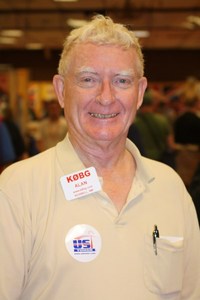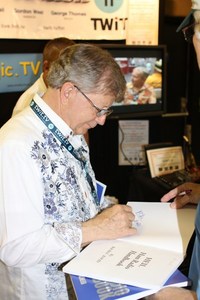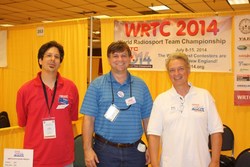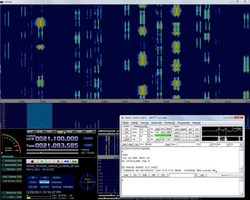 June 5, 2013 Editor: Ward Silver, NØAX | |||||||
IN THIS ISSUE
NEW HF OPERATORS - THINGS TO DO This weekend heralds the beginning of the summer sporadic E season on 6 meters and there have been some terrific openings over the past week - so you are excused from HF operating if you want to work on your VUCC totals! If the Magic Band seems flat, though, why not host a Kid's Day operation? BULLETINS There are no bulletins in this issue. BUSTED QSOS No problems were noted in the previous issue. CONTEST SUMMARY Complete information for all contests follows the Conversation section June 8-9
June 15-16
ARRL Contest Branch Manager, Sean Kutzko KX9X has changed categories to become the new ARRL Media and Public Relations Manager, replacing the recently retired Allen Pitts, W1AGP. The new Contest Branch Manager will be Mike DeChristopher N1TA. We all wish Sean well in his new job - contesting is good PR, you know! You may have met Mike if you needed some customer service regarding Logbook Of the World - he'll fit right in. Good luck to both gentlemen!
Just in time for this weekend's ARRL June VHF Contest, Dave W9PA (ex-W9ZRX) has posted a brand-new release of the VHF Super Check Partial Files at at www.k3lr.com/w9zrx/. Don't forget the trailing "/". Derived from 176 logs from recent ARRL VHF+ contests, the package consists of seven compressed "zip" files with various sortings of calls and grids. There are nearly 7000 call signs - thanks, Dave! Another master file maintainer, Jim AD1C, says, "I'm the process of re-designing the country (CTY) files web site. I am trying to retain all the original content. However, it may take a few days before most things have been restored. None of the contest files (downloads) have moved, all can still be found at the current URL. Other files will likely have to be moved to new URLs." If you depend on a particular URL for any reason, get in touch with Jim via the website. Hams love geography and contesters love games, as well. Why not combine them both in this new one: Geoguesser. (Thanks, Tom K1KI)
High-altitude ballooning has certainly taken many hams on flights of fancy and it sure is the summer launch season. You can find out about upcoming flights, technical information on the payloads, and even how to track the balloons once in the air - Paul KD4STH suggests you browse to the Amateur Radio High-Altitude Ballooning website and Bill WB8ELK's is full of good ideas, too - up, up, and away! Three new "smartphone satellites" are called Alexander, Graham and Bell. An easy way to find the satellites (also the small ones) is the homepage of N2YO. The standard "satellite" is the ISS, but you can select any other satellite at the head of the site. (Thanks, Ingo, DK3RED) Storm Chaser WJØG, Tim Samaras, son Paul, and crew member Carl Young were killed by the El Reno, Oklahoma tornado as reported by CNN. Tim was remembered in this Discovery channel show. Will we soon be pouring our bases, towers, and antennas from the same cement truck? Here's an interesting new technology that may be in your contracting future! (Thanks, Kirk K4RO) Web Site of the Week - CQ World Wide Contest Director, Randy Thompson K5ZD, has posted a set of rule changes on the CQ WW website. You can download and read them and make comments through June 25. Randy hopes that the rule changes will clean up the wording of the rules so they are easier for everyone to understand, including non-English speaking contesters. While the scoring remains unchanged, less popular rules and categories are planned to be replaced with new opportunities for competition. For example, there are new "Classic Single-Op" and "Rookie" overlay categories while the Team Competition and Xtreme categories will be dropped. Log checking penalties will be better-defined and in some cases reduced. The Yellow and Red Card system has itself been DQ'ed. You can read the rules online or download a PDF file. Comments should be submitted by email and will be used to improve the wording and revise the Frequently Asked Questions section of the website. The final version of the new rules will be announced on July 2, 2013. WORD TO THE WISE What happens to your log if you decide to change categories to a single-band entry halfway through the contest? Can the sponsors sort things out? Yes - if you specify the desired category and leave all of the contacts in your log. In the case of a single-band 40 meter log, CQ WPX, Director Terry N4TZ says, "Send in the entire log but in the Cabrillo header, make sure it says: CATEGORY-BAND: 40M instead of ALL. Leave other QSOs in log so that the other station's log can be cross-checked against yours. Larry K8UT gave this presentation at the Hamvention RTTY Forum about a survey regarding the MMTTY and 2Tone decoders. Joe KØNEB has published his annual slide show of Hamvention 2013 set to music. Enjoy "Freeze Frame" and there are some photos from the QRP mini-convention Four Days in May in there as well.
Atmospheric science is busy in the lower ionosphere - stratosphere region. These "red sprites" over clouds in South Dakota were recently published on the NASA "Astronomy Picture Of the Day" website. As yet unexplained, sprites and jets are the result of some kind of energy discharge in the upper atmosphere above thunderstorms. The multi-instrumentalist Raul Midón is also KB5ZOT, and he does it all at the same time! I bet he'd be a natural SO2R operator. (Thanks, Lloyd KH6LC) Electronic Design magazine continues to publish interesting presentations such as this third part of a series that features test equipment from the 1936-1955 period The extended and colorful writeup of the 2012 ARRL 10 Meter Contest by Scott Tuthill K7ZO is online for your reading pleasure. Another insightful writeup with lots of analysis on this popular contest.
CQ World Wide CW 2012 results have been posted to the web site along with some errata for the SSB and CW contests. (Thanks, CQ WW Director Randy K5ZD) Based upon the CQ WW 2012 errata, updated WRTC-2014 Event Scores are now posted for EU1, EU2, EU4 and EU5. (Thanks, Dan K1TO, WRTC-2014 Team Selection Director) The results of the 2013 KC DX Club Dayton CW Pileup Competition are now available for viewing on the Kansas City DX Club website. Results as far back as 1995 are also available there. Now only 51 weeks until Dayton 2014! (Thanks, Bill KØVBU) OPERATING TIP Here is some good information from the CQ WPX contest's Rules FAQ about the scoring penalties for errors detected during the log checking process. Obviously, not all contests are the same but this is typical of the way most sponsors treat the same logging errors. Incorrect call sign - loss of that QSO plus an additional penalty of the point value of the QSO (Thanks, Terry N4TZ, CQ WPX Contest Director) An "artificial antenna" can be created for tests of transmitter outputs, impedance matching circuits and the like - connect a normal antenna tuner backwards with a dummy load on the normal input. Any number of impedances can be created by changing the tuning. (Thanks, Don W3FPR) Rick K6VVA wrote in with word of a new toy - an IOGEAR Model GCS22U 2-Port USB KVM Switch with a one-touch remote switch to swap the monitor, keyboard and mouse between two different computers. This can even be adapted to use with a footswitch for hands-free swapping.
Improper connector installation plagues many ham stations, not only with RG-6 CATV connectors but with all types of coaxial connectors. An improperly installed connector is an invitation to RFI ingress and equipment damage. Frank W3LPL presents this detailed set of instructions for installing type F connectors on quad-shield RG-6 cable, common in home installations and for receiving antennas: Quad cable connector installation requires skills and patience. Compounding the problem, hams often use connectors that are not intended for use with quad-shield RG-6. Improper connector installation is so pervasive in the cable TV industry that CommScope prepared an illustrated paper on improper connector installation. Begin by using the correct connector for quad-shield cable. Proper installation involves five specific steps, each performed carefully and correctly: 1. Use an RG-6 stripping tool to remove the jacket. Inspect the braid wires to be sure none of the wires are damaged. Never use a knife to remove the jacket because inevitably it will damage the fragile braid wires no matter how careful you are. 2. Carefully fold back only the outer braid and spread the braid wires evenly around the circumference of the cable jacket. Verify that no wires are broken. All of the braid wires should lay flat over the jacket, should not be more than 1/4 inch long, and should not be bunched up. 3. Remove the foil tape between the two braid shields. Do not use a knife to assist in foil tape removal. This step is time consuming and often ignored. The connector will be very difficult to install if the foil tape is not removed. If somehow you manage to force the connector onto the cable with the foil tape in place, the connector will be intermittent and unreliable. 4. Carefully fold back the inner braid and spread the braid wires evenly around the circumference of the cable jacket. Verify that no wires are broken. All of the braid wires should lay flat over the jacket, should not be more than 1/4 inch long, and should not be bunched up. 5. Be sure the connector is fully seated. If you need to use great force to mate the connector something is wrong, either you used the wrong connector or the cable was improperly prepared. If somehow you manage to force the connector onto the cable, the connector will be intermittent and unreliable. Technical Web Site of the Week - The equations that we call Maxwell's equations were not really written by Maxwell - at least not in that form. Oliver Heaviside - a self-taught amateur - is responsible for having simplified the nearly two dozen equations from Maxwell into the handful used today. Another interesting but forgotten fact is that Heaviside also invented and patented coaxial cable! (Thanks, Jerry WAØACF) SDR at the ARRL Youth Lounge This issue features a report from ARRL Youth Editor, Sterling Coffey NØSSC on a neat setup he tried out at the Hamvention ARRL Expo's Youth booth. I wondered if the younger hams would enjoy an off-the-air contest using SDR data and a regular RTTY decoder and logging program. I know my local club's GOTA station has had a lot of success in using the digital modes to get new operators one the air without mike fright, QRM, and QRN that makes those first contacts difficult. Once familiar with the flow of a QSO, they often go on to make SSB QSOs. To test the idea, Bob N6TV supplied a very large file of captured SDR data during a recent RTTY contest. Sterling then set up the playback and logging system as described here. It was a big success as you'll see - keep reading! 73, Ward NØAX Every year for the past seven years, a "Youth Lounge" has been located in the red carpeted ARRL EXPO area. The lounge serves as a getaway for kids to hang out and learn about ham radio in unconventional ways. Many of our young hams and hams-to-be come and get hooked on ham radio scavenger hunts, phonetic hula-hooping, sending their names in CW, going on a mini-foxhunt, and building electronic snap kits for points. Their points are redeemed for all kinds of prizes ranging from 10-point pencil grips and stickers to 100-point gadgets, gizmos, Technician manuals, bubbles, balloons, and much more. A addition to the youth lounge this year was a bit of new technology. Software Defined Radio piqued the eyes and ears of our youths as it had many opportunities for points. The idea was to get the kids to listen to, tune in, and decode RTTY signals pre-recorded from a contest. Technical Details The PC was set up to play back a raw IQ file through a program called HDSDR. The program displays a waterfall diagram along with many controls at the bottom. I set it up so the kids could just click and decode the signals, rather than mess with filter bandwidths, modulations, frequencies, etc. HDSDR would decode the IQ .wav file, and using lower sideband we can decode signals. My computer had a soundcard feature called "Stereo Mix" which is simply takes the audio fed through the speakers, and loops it back as if it were a microphone. Other computers without this feature may need a program called Virtual Audio Cable, or you can simply plug a â " stereo patch cable from the headphone to the microphone jack of your computer soundcard.
Not So Technical Details Anyway the idea was simplicity. The kids would click and drag the filter (the light blue rectangle in the HDSDR window) until the RTTY peaks line up with the yellow lines in the MMTTY window. It would start to decode, and they would begin writing call signs. Each call sign they successfully decoded was worth 5 points, with a maximum of 10 call signs, totaling 50 points. There was a catch - you must retune every time you decode a call sign. Little did they know they were contesting! The kids caught on instantly. There was little to no confusion - the blue box goes over the pointy spikes in the big window, and the white spikes match with the yellow lines in the other window. There were times when the kids would play with the settings on HDSDR and change bandwidths and go to AM or FM (to see if they could hear the radio I suppose), so MMTTY would decode garbage. Easy-peasy fix. Also included was a live demonstration of a little USB based RTL-SDR receiver capturing signals from the 2 meter band in real time. Hara Arena is an RF nightmare if your job is interference protection (check out my Very Large Array blog at n0ssc.blogspot.com). However, it makes it very easy to tune in real-time signals. The $20 USB receivers can receive just about anything between 67 and 1700MHz. Using another program called SDR# (pronounced SDR Sharp, think back to your grade school music days) you can do the same as HDSDR, click and drag a filter and demodulate just about anything. They're not the hottest of receivers, but they are usually less than $20 - you get what you pay for. The RTL was connected to a SMA rubber-duckie antenna, and taped to the corner of my laptop screen. I tuned it to a few different frequencies, like FM broadcast, which was a hit with the kids, as well as the Hamvention talk-in frequency. One of our youths, Patrick Marshall KDØLNO, really enjoyed the whole idea of SDR, taking only a few minutes to find 10 call signs in the RTTY contest. He fiddled with the programs, tuned up all sorts of real-time signals in SDR#. I showed him a WebSDR receiver online that demodulates the entire HF spectrum...it was like he was glued to the seat! It was tough to give others a try for a while because he was mesmerized by the sounds and signals on HF. I also tried another new thing at the last minute: tuned to 144.390 at Hamvention, there are unceasing APRS packets beaconing positions of techy hams. I used a free program called AGWPE and AGWTerm to decode and display raw packets, and another cool program called APRSISCE/32 which connected to AGWPE and decoded the position packets, displaying positions of hundreds of hams in Dayton on a big map. The kids thought that was pretty cool, but I didn't think of a clever way to turn it into points. Maybe next year! The Youth Lounge is always improving year-by-year. Perhaps we'll implement a time limit for the kids to decode as many calls as possible, and put their names on a leaderboard to spark some friendly competition. We could try other modes as well, like SSB or PSK31. How did N6TV acquire the files? "I used a Perseus SDR receiver and the HDSDR software to record 8 minutes of the RTTY portion of 15 meters during the 2013 WPX RTTY contest, Saturday, February 9th, 2013, starting at 1909Z. The recording captured all of the RTTY activity from 21.070 to 21.130 MHz, and also some NCDXF CW beacon activity on 21.150. The .WAV file is over 340 MB. "Most of the time I kept my 5-element beam pointed towards the East Coast, but occasionally I moved it towards Europe to see if I could pick up some DX. The compressed 215 Mbyte file is still available for download and includes the instructions for capturing data in a separate Readme text file, also available separately without the SDR data." June 5 through June 18, 2013 An expanded, downloadable version of QST's Contest Corral in PDF format is available. Check the sponsor's Web site for information on operating time restrictions and other instructions. HF CONTESTS Kid's Day--Phone, from Jun 15, 1800Z to Jun 15, 2400Z. Bands (MHz): 3.5-28. Exchange: Name, age, location, favorite color. Rules NS Weekly Sprint--CW, from Jun 7, 0230Z to Jun 7, 0300Z. Bands (MHz): 1.8-14. Exchange: Serial number, name, S/P/C. Logs due: none. Rules WFF Green Days--Phone,CW,Digital, from Jun 8, 0000Z to Jun 9, 2359Z. Bands (MHz): 1.8-28. Exchange: RS(T) and WFF number if available. Logs due: 30 days. Rules DRCG Long Distance Contest--Digital, from Jun 8, 0000Z - See website. Multiple time periods. Bands (MHz): 3.5-28. Exchange: RST, CQ Zone, and UTC time. Logs due: Aug 1. Rules Australian Shires Contest--Phone,CW, from Jun 8, 0600Z to Jun 9, 0600Z. Bands (MHz): 3.5-28. Exchange: RS(T) and VK Shire or CQ Zone. Logs due: Sep 1. Rules Asia-Pacific Sprint--Phone, from Jun 8, 1100Z to Jun 8, 1300Z. Bands (MHz): 14-21. Exchange: RS and serial. Logs due: 7 days. Rules Portugal Day--Phone,CW, from Jun 8, 1200Z to Jun 9, 1200Z. Bands (MHz): 3.5-28. Exchange: RS(T) and serial or district code. Logs due: Sep 1. Rules GACW WWSA CW DX Contest--CW, from Jun 8, 1500Z to Jun 9, 1500Z. Bands (MHz): 3.5-28. Exchange: RST, CQ zone. Logs due: Jul 30. Rules Straight Key Weekend Sprintathon--CW, from Jul 13, 1200Z to Jul 14, 2359Z. Bands (MHz): 1.8-28, 50. Exchange: RST, QTH, name, member nr if member. Logs due: 5 days. Rules NAQCC Monthly QRP Sprint--CW, from Jun 12, 0030Z to Jun 12, 0230Z. Bands (MHz): 3.5-14. Monthly on 2nd Tuesday or 3rd Wednesday local time (alternating). Exchange: RST, S/P/C, and NAQCC mbr nr or power. Logs due: 4 days. Rules CWops Monthly Mini-CWT Test--CW, from Jun 12, 1300Z - See website. Multiple time periods. Bands (MHz): 1.8-28. Twice monthly on 2nd and 4th Wed, 18 to 28 kHz above band edge. Exchange: Name and member number or S/P/C. Logs due: 2 days. Rules All-Asian DX Contest--CW, from Jun 15, 0000Z to Jun 16, 2400Z. Bands (MHz): 1.8-28. Exchange: RST, operator age (YL may send 00). Logs due: Jul 31. Rules Stew Perry Warmup Contest--CW, from Jun 15, 1500Z to Jun 16, 1500Z. Bands (MHz): 1.8. Exchange: 4-char grid square. Logs due: 30 days. Rules QRP ARCI QRP Shootout--Phone,CW, from Jun 15, 1500Z - See website. Multiple time periods. Bands (MHz): 1.8-28. See website - CW on Saturday, SSB on Sunday. Exchange: RST, S/P/C, power or QRP ARCI number. Logs due: 14 days. Rules West Virginia QSO Party--Phone,CW,Digital, from Jun 15, 1600Z to Jun 16, 0200Z. Bands (MHz): 3.5-28. CW--35 kHz from band edge, Phone--35 kHz from General/Nov/Tech segments. Exchange: RS(T), WV county or S/P/C. Logs due: Jul 20. Rules Feld-Hell Field Day Sprint--Digital, from Jun 15, 2000Z to Jun 15, 2200Z. Bands (MHz): 28. Monthly on 3rd Saturday. Exchange: RST, S/P/C, Feld-Hell member nr. Logs due: 7 days. Rules Run For the Bacon--CW, from Jun 17, 0100Z to Jun 17, 0300Z. Bands (MHz): 1.8-28. Monthly on 3rd Sunday night (local). Exchange: RST, S/P/C, Flying Pig nr or power. Rules VHF+ CONTESTS ARRL June VHF Contest--Phone,CW,Digital, from Jun 8, 1800Z to Jun 10, 0300Z. Bands (MHz): 50+. Exchange: Grid square. Logs due: Jul 11. Rules Worldwide EME Contest--Phone,CW, from Jun 15, 0000Z to Jun 16, 2400Z. Bands (MHz): 2.3G. Exchange: TMO/RS(T) and "R". Logs due: Jun 25. Rules REF DDFM Six Meter Contest--Phone,CW, from Jun 8, 1600Z to Jun 9, 1600Z. Bands (MHz): 50. Exchange: RST, serial number, grid square. Logs due: 15 days. Rules SMIRK QSO Party--Phone,CW, from Jun 15, 0000Z to Jun 16, 2359Z. Bands (MHz): 50. Exchange: Grid square and member number. Logs due: Aug 1. Rules WAB 50 MHz Phone--Phone, from Jun 16, 0900Z to Jun 16, 1500Z. Bands (MHz): 50. Exchange: RS, serial, WAB square or DXCC entity. Logs due: Jul 7. Rules Straight Key Weekend Sprintathon--CW, from Jul 13, 1200Z to Jul 14, 2359Z. Bands (MHz): 1.8-28, 50. Exchange: RST, QTH, name, member nr if member. Logs due: 5 days. Rules LOG DUE DATES June 5 through June 18, 2013
ARRL Information Click here to advertise in this newsletter, space subject to availability. Your One-Stop Resource for Amateur Radio News and Information ARRL membership includes QST, Amateur Radio's most popular and informative journal, delivered to your mailbox each month. Subscribe to NCJ - the National Contest Journal. Published bimonthly, features articles by top contesters, letters, hints, statistics, scores, NA Sprint and QSO Parties. Subscribe to QEX - A Forum for Communications Experimenters. Published bimonthly, features technical articles, construction projects, columns and other items of interest to radio amateurs and communications professionals. Free of charge to ARRL members: Subscribe to The ARRL Letter (weekly digest of news and information), the ARES E-Letter (monthly public service and emergency communications news), Division and Section news -- and much more! ARRL offers a wide array of products to enhance your enjoyment of Amateur Radio. Visit the site often for new publications, specials and sales. Donate to the fund of your choice -- support programs not funded by member dues! Reprint permission can be obtained by sending email to permission@arrl.org with a description of the material and the reprint publication. ACKNOWLEDGEMENTS ARRL Contest Update wishes to acknowledge information from WA7BNM's Contest Calendar and SM3CER's Contest Calendar. | |||||||












